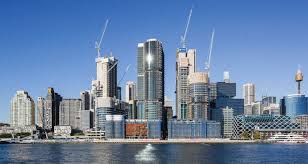CONSTRUCTION INDUSTRY – EMBRACING CHALLENGE AND CREATING OPPORTUNITY

Sydney has 42% of all cranes Nationally and the lowest unemployment rate at 3.9%. Here are some of the challenges and opportunities being created within one of our most dynamic and valuable industry sectors – Construction.
During the first quarter of 2019, there were 735 cranes across Australia, with 530 for residential projects and 205 non-residential developments, including offices, transportation, hotels, education, health and retail. Sydney has 42% of all cranes nationally.
Every industry sector is going through change and evolving at a rapid rate. Change and the ability to keep up and adapt easily whilst continually lifting performance is becoming the “new norm”.
The construction industry is no exception. The ability to stay ahead of competitors and maintain a growing, sustainable business requires a great deal of insight to help see the bigger picture locally and across Australia. What’s shaping the industry, major challenges and viable solutions are at the top of everyone’s agenda.
The construction sector in Australia is the third largest industry for the number of people employed and its share in GDP (Gross Domestic Product).
Nearly 1.2 million people were employed in construction in 2018, which is nearly 9.5% of all jobs in Australia. It’s estimated a further 100,000 jobs will be added by 2022.
The construction industry contributes $134,2 billion to the economy and has a share of 8% in the total GDP of the country. Healthcare and retail are the only sectors outperforming these numbers.
Pain Points and Opportunities
If you are an employee or business leader, here are some of the challenges and opportunities within the construction industry;
- Projects Go Over Time and Over Budget
Typically delays beyond the original construction schedule are common within a specific range, and large projects can take 20% longer to finish. Aside from managing suppliers, productivity challenges, on and off site, remain a key contributor.
- Skills Shortage
Australia’s low unemployment level of 5.7% is contributing to hiring challenges and talent shortages for trade, engineering and technical people. NSW has the Nation’s lowest unemployment rate at 3.9%. We continue to see jobs in high demand including;
- Project Managers
- Site Managers
- Engineers, Civil, Design, Electrical
- Estimators
- Contract Administrators
- Project Lead Architects
- Facilities Managers
- Project Coordinators
- Property and Construction Lawyers,
- Residential Property Managers,
The average annual income for Construction Managers, Site Managers, Estimating Managers, Strategic Sourcing Manager or General Manager is $100,000 to $280,000
Apart from qualifications and experience, employers are showing an increased demand for people with a broad range of soft skills including:
- Communication skills,
- Planning,
- Detail oriented,
- Building effective relationships,
- Microsoft Office.
In the trade sector, the market is struggling to deliver valuable skills including;
- Plumber
- Electrician
- Bricklayers
- Carpenter
- Electrician
- Fibrous Plasterer
- Glazier
- Painting trade worker
- Roof tiler
- Wall and floor tiler
We are seeing more women entering the construction industry in various roles including trades, estimating, engineering, project management and contract administration roles. The Australian Bureau of Statistics reports females make up around 12% of the construction workforce in Australia.
- Lack of Innovation
The industry continues to lag behind technologically, maintaining a manual approach. Organisations are reviewing the scale of double handling and how process is managed within back office and site office functions, coordination, paperwork and data processing with a view to embracing digital technologies and more innovative work practices.
- Productivity and Rework
It appears the construction sector is grappling with ways to increase productivity, falling behind other key sectors including Mining, Health and Agribusiness. Dealing with conflict resolution and rework is consuming countless work hours, up to 14 hours per week, and taking precious focus and time away from high priority tasks.
- Keeping Employees Safe
Construction remains in the top three industries presenting a risk to the lives of its employees. According to Safe Work Australia, the rate of work-related injury fatalities has decreased by 48%. Most employers are dedicated to implementing higher safety standards which has been reflected in the increased number of Health, Safety and Environment roles created.
- Staying Competitive
All industry sectors experience sales and revenue fluctuations. It’s critical to ensure that the scale of the dips in revenue or workload are minimised with a strong focus on effective transition from one construction site to another. The decline in residential building approvals is presenting a challenge, requiring the need to reassess workforce planning and talent acquisition plans. The ability to engage candidates with transferable skills across various industry sectors will help safeguard against sudden fluctuations, as well as keeping a close eye on industry insights, trends, technological and policy changes.
- Recognition and Development to Improve Retention
Maintaining a high performing workforce and keeping teams engaged and motivated is a key concern for most business leaders in the construction sector. Quality training and development through external providers and knowledge sharing with internal subject matter experts will gain further trust and commitment. Continuous training, upskilling and recognition will help elevate performance and the ability to successfully prepare for shifts in the construction market.



